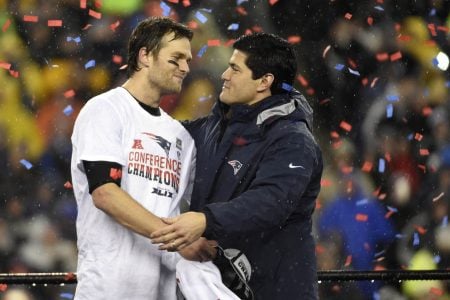Washington said they put Smith in place of Ventrone, and that put other players in different positions, and that caused the breakdown.
Partially correct. After the first kickoff, they put in LeKevin Smith and Heath Evans for Ray Ventrone and Mike Richardson. Both were interior guys on the left side of the kickoff line; the Leon Washington TD was returned on the Pats' right.
When the Pats kicked the ball to a side of the field, they put 6 on the short side and 4 on the long side. On the TD return the wide side was, from center to boundary: Sam Aiken, Jason Wilhite, Kelley Washington. Larry Izzo was the safety on that side.
The Jets were running a kind of double-wedge shell where the front line would retreat to 30 yards and set up for contact in front of the wedge. It is more common for the frontline to retreat to the same or shorter distance, make a V-turn and try and pick up angle blocks while moving across the field, steering bodies away from the wedge.
It was a smart move for the Jets to do it this way because the Pats defensive players have a bias for gap-control over penetration. The moving angle blocks are useful for keeping fast, penetrating players from demolishing the wedge. The flat contact blocks of the Jets' front line tended to cause the Pats players to seek their contact and try to "control" the gaps in that line. Then the wedge, which was moving at speed behind this, could blow out a hole in the stationary coverage unit and Leon Washington could make his cut and go. Jets got a good return on the first kickoff just because of these facts.
On the touchdown return, Wilhite got so tentative trying to read the blocking that he ended up playing the same position as Larry Izzo, the backside safety. He, Izzo and Aiken, who got double-teamed by the contact guys because the Jets didn't have to block Wilhite, all wound up in the same position on the shortside hash at the 30. Washington, the contain guy, was 8 yards downfield on the same hash. That left an 8-yard hole for Leon Washington to run through.
Most of the wedge blocked right, picking up the Pats overload, one Jet linebacker got a chip on Wilhite, who was trying to close the hole, and Leon Washington simply cut backside across both hashes, and ran away from the Pats pursuit. Because every Pat was on the shortside hash or beyond, once Washington crossed the hashes the only Pat with any kind of angle on him was Gostkowski at the 35.
Primary fault on the play was Wilhite, followed by Izzo. Izzo simply lost his leverage on the play, Wilhite didn't accomplish anything constructive. Minor demerits to everyone because nobody got effective penetration, closest we got to Leon Washington was James Sanders, who bounced off a stiff block.
Neither of the two replacements on the strong side materially affected the coverage's failure. In fact, Ventrone's replacement, Smith, did a decent job busting the wedge.

















